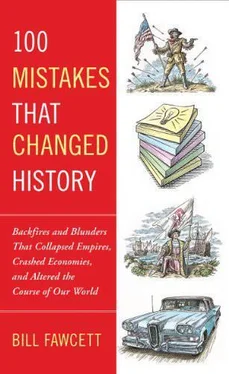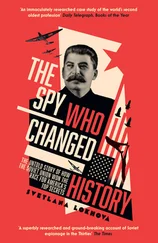59. TOO SUCCESSFUL A DEVIOUS PLAN
The Enemy of My Enemy
1917
This mistake is one of a lack of foresight. In April 1917 a truck, sealed almost airtight, entered Germany from Bern, Switzerland. In that truck were nineteen Russians. All nineteen had been considered too dangerous to allow to travel through, or even enter, virtually any nation in Europe. Only adamantly neutral Switzerland would tolerate them. Now they were going home. One of the nineteen men in that truck was Vladimir Lenin. The Russian revolutionary had fled the czar’s secret police and eventually ended up in Switzerland. From there he coordinated the actions of his outlawed and small, but fanatical, Bolshevik Party.
The start of World War I had made any communications with Russia difficult. It was a most frustrating time for a revolutionary being cut off and far from the action. Finally, Lenin approached the ambassador to Switzerland from one of the nations where he had been one of the most wanted enemies of the state, Germany. The kaiser’s government did not like revolutionaries. But Germany was three years at war, and losing. One of the nations allied against Germany was controlled by the same Russian government Lenin wished to overthrow. His promise of leading a revolution and then taking Russia out of the war was enough to interest the hard-pressed Germans. They agreed to return him to his native country. It is unlikely that anyone in the German army actually expected Lenin and the Bolsheviks to really seize power. There were barely 50,000 Bolsheviks spread across dozens of cities among the tens of millions of people living in Russia. But obviously anything that distracted the new Menshevik or Kerensky government, who had kept Russia in the war after the czar abdicated, would benefit Germany.
So Vladimir Ilyich Lenin was sneaked into Russia by the German army. He was even given some operating money. To the surprise and dismay of Germany, by November Lenin had succeeded. Alexander Kerensky, a middle-class moderate, had made a number of poor decisions, including keeping Russia in the unpopular war, allowing food costs to remain so high few soldiers or workers could afford to eat, and not redistributing land to the desperate peasants who had reluctantly supported him. When the Bolsheviks finally acted, only one small military unit, the Petrograd Women’s Battalion, actually fought to defend the unpopular Menshevik government.
In the short term, the German army got what it wanted. Lenin kept his word and withdrew Russia from the alliance fighting Germany. The German government then demanded a high price for what they had already done. They wanted to be given Poland, the Baltic nations, and Ukraine. Lenin and Russia refused, and with those demands and refusal, any slight goodwill between the two nations was lost. Germany assisted Poland and the White armies to battle the Red Army for almost another decade.
But by the time Russia had withdrawn from the war, it was too late to save the kaiser’s war effort. The German troops who hurried west arrived in time to die in the Verdun offensive. That offensive had been the last hope for Germany to defeat the Allies before the power of the United States could affect the war. The Germans were stopped at Verdun, and soon fresh and enthusiastic American soldiers had more than balanced out any German reinforcements from the Eastern Front.
It was years until the Red Army actually controlled all of Russia. By the time it did, the enmity with Germany was mutual and intense. Stalin now led Russia, and communists were aggressively pursuing world domination. It is surprising that Russia was almost as self-defeating when it assisted in the secret training of the German army. But that is a mistake of its own.
So while in the short term the German army got what they wanted by smuggling Lenin back into Russia, doing so may have been one of the worst judgment calls ever made in the twentieth century. The Bolsheviks were one of the smallest and most radical of all the many revolutionary movements in Russia. Without Lenin’s genius, the Bolsheviks would likely have remained a minor, extremist group of no importance. The much more moderate Mensheviks, or at least a less reasonable populist government, would instead have emerged.
No Lenin, then no Stalin. The millions of Ukrainians and Kulaks Stalin killed to allow the collectivization of the farms and factories would have lived. In Germany, the strong Communist Party led to a political reaction that in 1933 put the Nazi Party in power. So if those German intelligence officials had not decided to send Lenin back to Russia, there might not have been the mass programs and starvation in Russia in the 1930s: no Nazis, no Holocaust, no World War II, no Cold War, no Mao Zedong, no Castro. Assisting Lenin and enabling the Bolshevik revolution that gave rise to communism just may be one of the worst, world-changing mistakes in this book.
A Fine Crop of Dust
1917
Europe was hungry. World War I was raging, and many European farmers were now in the army. The nitrates that would have gone into fertilizer were being used to make munitions. So it was decided that the United States needed to grow more food. The way to do that was to plow formerly unused lands and plant wheat or corn on them. This came at a time when there was also a period of unusually high rainfall. That was fortunate in that it made a lot of marginal land productive. It was unfortunate because the extra rainfall didn’t last.
The encouragement to plant came from the U.S. Food Administration (USFA), which was founded as part of the Food and Fuel Control Act passed August 10, 1917. The USFA was created to encourage more food production and to control the distribution of agricultural products. So the USFA turned to the most traditional way to encourage an activity. They offered a bonus payment for every acre on which corn was planted. The bonus was enough to make corn growing profitable even on marginal land. Even less fertile soil in normally dryer states was used to grow wheat. The guaranteed high prices from the USFA subsidized the plowing of new lands in such states as Kansas, Oklahoma, Texas, and New Mexico. The soil in those states was normally too dry for wheat, but thanks to a few seasons of unusually high rains, large crops of wheat were possible.
When World War I ended so did the subsidies. A few of the new farms were able to get in several more good wheat crops, but many others were abandoned. Within a decade, there were only a few of the new farms left. They were replaced by ranchers raising cattle and horses, just like the farmers had replaced those ranchers when the land was first converted to crops. But there was a difference now. Before the land was farmed, the soil had been held together by the roots of sturdy, slow-growing grass. But that grass had all been plowed under. So with that ground cover gone, the hooves of the animals chewed up the unprotected soil.
Then in 1934, strong winds blew for weeks across the Southwest. Millions of acres of already pulverized soil turned to dust. Dust clouds, know as dusters or black blizzards, covered the skies. When they had ended, what little fertility the dry land once had was gone. So badly had the soil been ruined that any period of high winds created mini dust bowls up to as late as the 1950s.
For a few years, American wheat was able to feed the doughboys and our allies. The cost of that wheat was millions of acres of grazing land lost. The lives of tens of thousands of farmers were ruined and the Great Depression was made even worse. The drama was so tragic and widespread that it was the theme of one of John Steinbeck’s greatest novels, The Grapes of Wrath .
Читать дальше












